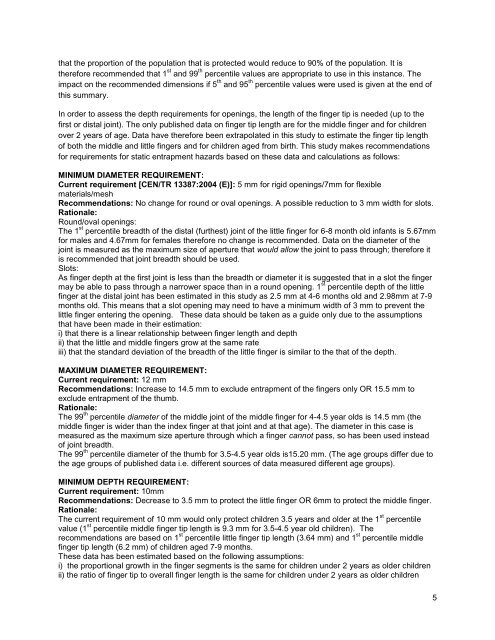Requirements for finger entrapment in European safety ... - ANEC
Requirements for finger entrapment in European safety ... - ANEC
Requirements for finger entrapment in European safety ... - ANEC
You also want an ePaper? Increase the reach of your titles
YUMPU automatically turns print PDFs into web optimized ePapers that Google loves.
that the proportion of the population that is protected would reduce to 90% of the population. It is<br />
there<strong>for</strong>e recommended that 1 st and 99 th percentile values are appropriate to use <strong>in</strong> this <strong>in</strong>stance. The<br />
impact on the recommended dimensions if 5 th and 95 th percentile values were used is given at the end of<br />
this summary.<br />
In order to assess the depth requirements <strong>for</strong> open<strong>in</strong>gs, the length of the <strong>f<strong>in</strong>ger</strong> tip is needed (up to the<br />
first or distal jo<strong>in</strong>t). The only published data on <strong>f<strong>in</strong>ger</strong> tip length are <strong>for</strong> the middle <strong>f<strong>in</strong>ger</strong> and <strong>for</strong> children<br />
over 2 years of age. Data have there<strong>for</strong>e been extrapolated <strong>in</strong> this study to estimate the <strong>f<strong>in</strong>ger</strong> tip length<br />
of both the middle and little <strong>f<strong>in</strong>ger</strong>s and <strong>for</strong> children aged from birth. This study makes recommendations<br />
<strong>for</strong> requirements <strong>for</strong> static <strong>entrapment</strong> hazards based on these data and calculations as follows:<br />
MINIMUM DIAMETER REQUIREMENT:<br />
Current requirement [CEN/TR 13387:2004 (E)]: 5 mm <strong>for</strong> rigid open<strong>in</strong>gs/7mm <strong>for</strong> flexible<br />
materials/mesh<br />
Recommendations: No change <strong>for</strong> round or oval open<strong>in</strong>gs. A possible reduction to 3 mm width <strong>for</strong> slots.<br />
Rationale:<br />
Round/oval open<strong>in</strong>gs:<br />
The 1 st percentile breadth of the distal (furthest) jo<strong>in</strong>t of the little <strong>f<strong>in</strong>ger</strong> <strong>for</strong> 6-8 month old <strong>in</strong>fants is 5.67mm<br />
<strong>for</strong> males and 4.67mm <strong>for</strong> females there<strong>for</strong>e no change is recommended. Data on the diameter of the<br />
jo<strong>in</strong>t is measured as the maximum size of aperture that would allow the jo<strong>in</strong>t to pass through; there<strong>for</strong>e it<br />
is recommended that jo<strong>in</strong>t breadth should be used.<br />
Slots:<br />
As <strong>f<strong>in</strong>ger</strong> depth at the first jo<strong>in</strong>t is less than the breadth or diameter it is suggested that <strong>in</strong> a slot the <strong>f<strong>in</strong>ger</strong><br />
may be able to pass through a narrower space than <strong>in</strong> a round open<strong>in</strong>g. 1 st percentile depth of the little<br />
<strong>f<strong>in</strong>ger</strong> at the distal jo<strong>in</strong>t has been estimated <strong>in</strong> this study as 2.5 mm at 4-6 months old and 2.98mm at 7-9<br />
months old. This means that a slot open<strong>in</strong>g may need to have a m<strong>in</strong>imum width of 3 mm to prevent the<br />
little <strong>f<strong>in</strong>ger</strong> enter<strong>in</strong>g the open<strong>in</strong>g. These data should be taken as a guide only due to the assumptions<br />
that have been made <strong>in</strong> their estimation:<br />
i) that there is a l<strong>in</strong>ear relationship between <strong>f<strong>in</strong>ger</strong> length and depth<br />
ii) that the little and middle <strong>f<strong>in</strong>ger</strong>s grow at the same rate<br />
iii) that the standard deviation of the breadth of the little <strong>f<strong>in</strong>ger</strong> is similar to the that of the depth.<br />
MAXIMUM DIAMETER REQUIREMENT:<br />
Current requirement: 12 mm<br />
Recommendations: Increase to 14.5 mm to exclude <strong>entrapment</strong> of the <strong>f<strong>in</strong>ger</strong>s only OR 15.5 mm to<br />
exclude <strong>entrapment</strong> of the thumb.<br />
Rationale:<br />
The 99 th percentile diameter of the middle jo<strong>in</strong>t of the middle <strong>f<strong>in</strong>ger</strong> <strong>for</strong> 4-4.5 year olds is 14.5 mm (the<br />
middle <strong>f<strong>in</strong>ger</strong> is wider than the <strong>in</strong>dex <strong>f<strong>in</strong>ger</strong> at that jo<strong>in</strong>t and at that age). The diameter <strong>in</strong> this case is<br />
measured as the maximum size aperture through which a <strong>f<strong>in</strong>ger</strong> cannot pass, so has been used <strong>in</strong>stead<br />
of jo<strong>in</strong>t breadth.<br />
The 99 th percentile diameter of the thumb <strong>for</strong> 3.5-4.5 year olds is15.20 mm. (The age groups differ due to<br />
the age groups of published data i.e. different sources of data measured different age groups).<br />
MINIMUM DEPTH REQUIREMENT:<br />
Current requirement: 10mm<br />
Recommendations: Decrease to 3.5 mm to protect the little <strong>f<strong>in</strong>ger</strong> OR 6mm to protect the middle <strong>f<strong>in</strong>ger</strong>.<br />
Rationale:<br />
The current requirement of 10 mm would only protect children 3.5 years and older at the 1 st percentile<br />
value (1 st percentile middle <strong>f<strong>in</strong>ger</strong> tip length is 9.3 mm <strong>for</strong> 3.5-4.5 year old children). The<br />
recommendations are based on 1 st percentile little <strong>f<strong>in</strong>ger</strong> tip length (3.64 mm) and 1 st percentile middle<br />
<strong>f<strong>in</strong>ger</strong> tip length (6.2 mm) of children aged 7-9 months.<br />
These data has been estimated based on the follow<strong>in</strong>g assumptions:<br />
i) the proportional growth <strong>in</strong> the <strong>f<strong>in</strong>ger</strong> segments is the same <strong>for</strong> children under 2 years as older children<br />
ii) the ratio of <strong>f<strong>in</strong>ger</strong> tip to overall <strong>f<strong>in</strong>ger</strong> length is the same <strong>for</strong> children under 2 years as older children<br />
5
















